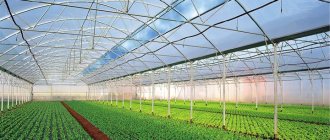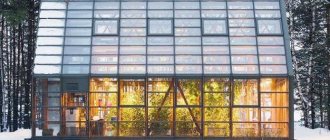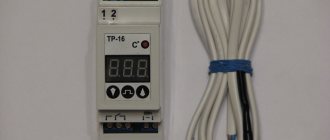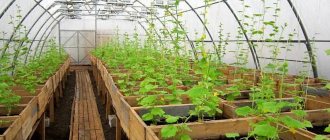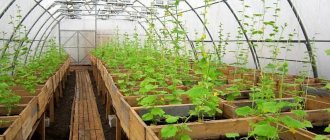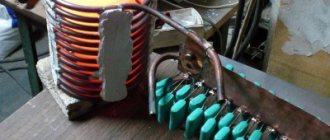Winter greenhouses have recently gained no less popularity than their summer counterparts. And it’s not surprising: after all, vegetables, herbs and berries in the “off season” are more expensive and have greater value in themselves, since they are rare. The design of a winter greenhouse differs from its summer counterpart in that it has thicker walls, strength, reliability, tightness and, of course, the presence of heating.
Most often, such structures are now made from modern material - cellular polycarbonate, which has flexibility, durability, environmental friendliness, and other important characteristics. In the article, we will look at the features of a winter polycarbonate greenhouse with heating: we will find out what types of greenhouse heating there are, and how to correctly calculate its required power. In addition, we will find out how to make such a greenhouse on our own.
Peak Heat Load Calculation
In January, heating the greenhouse will require 57 kW/h at night. During the day, the influx from solar energy reduces the load to 31 kW/h.
In August, 21 kWh will be required to cool the greenhouse.
More details about thermal engineering calculations and an example of a calculation table can be found in our blog.
Thermal conductivity parameters of structural elements
Frame wall 142mm U=1.27 W/m2/S, mineral wool insulation U=0.3 W/m2/S. Thermal conductivity of a double film with an air gap is U=4 W/m2/S [1, 8]. Floor on the ground U=0.36 W/m2/S (6).
Infiltration
The influx from the street is estimated at 109 m3/hour, taking into account the height of the building, weather and wind factors and the air exchange rate at a pressure of 50 Pa, ACH50 = 3 air volumes per hour [9].
Heat load of plants
When plants evaporate water, they lower the air temperature in the greenhouse.
2040 bushes at ~4.4 watt/hour/bush with watering 0.2 l/day/bush [6].
Lighting
Turns on in the evening for 5 hours. Luminous flux density 5 watt/m2. It is not the main source of light for plant growth, in which lighting can be 300 - 500 watt/m2 [3, 6].
Solar energy
The heat flow from the sun is calculated based on the angle of incidence of the sun's rays and the position and inclination of the surface towards the sun [1].
Angle designations for calculating heat from the sun [1] qs = A * E * cosθ * SHGC [1]. where qs is the heat flux from the sun, kW/h A is the surface area, m2 E is direct solar radiation, kW/h/m2 (2) θ is the angle of incidence of solar rays (3) SHGC is the solar energy absorption coefficient of the surface
Calculator for calculating the heating power of a greenhouse - with the necessary explanations
The presence of a plot outside the city quite often implies carrying out certain agricultural work on it. We must agree that every person is pleased to have on his own table vegetables, fruits or berries grown with his own hands and guaranteed to be “the purest”. But it’s true that the summer “gardening” season in most regions is quite short. Thanks to this, zealous owners build specialized agrotechnical buildings - greenhouses and hotbeds. And in order to bring the period of agricultural work to the expected limit, or even switch to a year-round cycle, you will probably need to equip the greenhouse with a heating system.
Greenhouse heating power calculator
The heating system of a greenhouse can be very different - long-burning stoves, water or electrical circuits buried in the soil according to the “heated floor” principle, convector heaters that ensure the movement of warm air masses, infrared heating. But each of the selected systems must perform the main task - to create and maintain the temperature required for the crops grown in the room, in other words, to have a specific heating capacity. But which one? – a calculator for calculating the heating power of a greenhouse will help us in this matter.
Below, under the calculator, explanations and necessary reference data are shown.
Greenhouse heating power calculator
Explanations for calculations
The power of the greenhouse heating system should be sufficient to compensate for heat losses, and with large glazing areas of these buildings they are very considerable.
The calculation of the required heat power is based on the following ratio:
Qt = Sw? Kinf? ?t ? ?w
Qt – calculated heating power.
Sw is the glass area of the greenhouse. Specifically, it is taken into account, since not only insolation (penetration of the energy of the sun's rays) passes through translucent walls, but also the largest amount of heat loss.
The area is calculated on your own, using the famous geometric formulas.
For those who have difficulty calculating area...
Some geometric shapes do not want to directly “obey” simple formulas, and they have to be divided into sections. How to calculate the area - also for difficult cases, with examples and calculators - in a specialized article on our portal.
Kinf – in other words, infiltration indicator. It depends on the approximate operating conditions of the greenhouse, in other words, on the desired temperature in the middle of the building, and the expected temperature level on the outside, on the street. Naturally, it would be a good idea to keep in mind the most unfavorable permissible conditions in order to ensure the required operational power reserve.
The infiltration coefficient values can be taken from the table below:
?t is the largest temperature amplitude, in other words, the difference between the normal value indoors and a very small value outdoors, in the coldest week during the life of the greenhouse. In the calculator, the value ?t will be calculated based on the specified values inside and outside.
— Basically, + 18? C is enough to grow a lot of vegetables. For seedlings or flowers, about + 25? C is required. When growing some exotic plants, the temperature regime also implies fairly high values.
— The field for entering external temperatures indicates the level of slight negative ambient temperature characteristic of this region during the service life of the greenhouse.
?w is an indicator of the thermal conductivity of the greenhouse glazing material.
Various materials (by composition and by building) have their own heat conductivity - it is already taken into account in the calculator method. The option of a greenhouse with a film-based coating is not being considered, since it would be an exaggeration to perceive it as truly a “winter” building.
The resulting value, in kilowatts, will become a guideline when selecting the best greenhouse heating system.
Is it difficult to build a greenhouse on your own?
The issue is controversial, since greenhouses can vary significantly in size, basic design, equipment and other properties. But still, this is quite doable, and a number of useful tips on this problem can be obtained in a specialized publication on the portal - about building a greenhouse with your own hands.
Greenhouse microclimate
A vapor pressure deficit (VPD) between the plant stem and the air in the greenhouse promotes the movement of water from the roots to the leaves. The target VPD value is usually in the range of 0.5 to 1.5 kPa [7]. Control of the vapor pressure deficit in the greenhouse is carried out by maintaining a given dew point, which takes into account both temperature and humidity [5].
For example, with a target VDP value of 1 kPa and a desired greenhouse temperature of 23C, the relative humidity is 64%, the absolute humidity is 11.35 g/kg, and the dew point is 16C.
Read more about calculating the amount of water to humidify rooms in our blog.
CO2 concentration: 1400 – 2200 mg/m3 [1].
Features of polycarbonate
This material is currently widely used in the construction of various structures. It is also ideal for constructing greenhouses: both summer and winter versions.
Noteworthy features of polycarbonate include its strength, which is combined with lightness. In addition, polycarbonate is an elastic material, which makes it possible to construct structures of various shapes from it.
Arches of any degree of curvature, various geometric shapes: all this can be easily done using polycarbonate.
The material transmits light remarkably. According to research by the developers, polycarbonate transmits approximately 85% of sunlight. In addition, this unique material is an excellent heat insulator, and plants in such a greenhouse are quite comfortable. Thanks to the thermal insulation properties, greenhouse owners spend less expensive resources on heating: quite significant savings result.
In the video - winter polycarbonate greenhouses with heating:
Calculation of air heating / cooling
The air change rate (ACH) for air heating of greenhouses is 5 - 8 air volumes per hour [7].
The air flow for this greenhouse is estimated at 5000 m3/hour. Supply air parameters:
- January: Temperature 36C, absolute humidity 13.5 g/kg, relative humidity 35%.
- August: Temperature 16C, absolute humidity 9.2 g/kg, relative humidity 81%.
The speed of air movement in the greenhouse is 0.5 - 0.7 m/s (more than 1 m/s interferes with plant growth, more than 5 m/s can cause physical damage to plants). The speed of air movement on plant leaves is 0.03 - 0.1 m/s [1].
Heat consumption standards for greenhouses
Heat consumption standards for greenhouses
If it is not necessary to install heating systems for a temporary seasonal greenhouse, then a year-round structure requires mandatory heating. Moreover, it is very important to calculate the heat consumption rates for the greenhouse in advance. This is done in order not to spend extra money on unnecessary additional equipment. Or, on the contrary, by setting up minimal heating, do not freeze the plants.
Thermal calculation of a greenhouse is an important step in planning the entire future structure.
Bibliography […]
- ASHRAE Fundamentals volume. 1997
- Manual J Residential Load Calculation. ACCA. 1986
- Indoor Agriculture: HVAC System Design Considerations. Trane Engineers Newsletter volume 48-3. 2019
- Grow Room Load Determination. Application Note 25. Desert Aire's. 2019
- Grow Room Environmental Control. Application Note 26. Desert Aire's. 2019
- HVAC Systems and Grow Room Energy Usage. Application Note 27. Desert Aire's. 2019
- Vapor Pressure Deficit and HVAC System Design. Application Note 28. Desert Aire's. 2019
- Hyung-Kweon Kim etc. Estimation of Thermal Performance and Heat Loss in Plastic Greenhouses with and without Thermal Curtains. Energies article. March 2018
- ANSI/ASHRAE Standard 62.2-2013, Ventilation and Acceptable Indoor Air Quality in Low-Rise Residential Buildings
How to calculate boiler power for a greenhouse
Whatever type of heating is chosen, in any case it is expensive to heat a greenhouse. Despite high-quality sealing, large heat losses cannot be avoided, and, therefore, it is necessary to heat intensively. Otherwise the plants will freeze.
A particular boiler is selected based on accurate calculations of all losses and the required load. You also need to pay attention to the efficiency of the boiler itself and what fuel it runs on. All this data allows you to calculate the peak load on the greenhouse heating system.
By the way, when choosing a boiler, you need to take into account the fact that its maximum power should exceed the calculated one by a maximum of 20 percent. If something happens, it’s easier to turn down the heating using a thermostat than to buy an additional boiler.
Experts also advise taking two boilers so that they operate at 60-70 percent of their capacity. Or use one of them as a spare in case the main one breaks down.
DIY water heating of a greenhouse
The most profitable way to heat greenhouses is water heating. You can make this greenhouse heating yourself, or rather the electric water heater itself, in stages:
- Cut off the top of the old fire extinguisher;
- Inside at the bottom we install a heating element with the required power of 1 kW. Alternatively, it could be a heating element from a samovar;
- It is necessary to make a removable lid for further filling of water;
- We attach 2 tubes to the unit body, which are connected directly to the radiator. When working with pipes, it is imperative to use gaskets, no matter what leaks occur. If you want the unit to work automatically, you need to use an AC relay and a voltage of 220 V.
When carrying out work on installing a greenhouse heating system, the main thing is to comply with the rules and regulations, instructions and safety precautions.
More on this topic on our website:
- Correct calculation of heating in an apartment building and in an apartment Although ordinary people believe that they have no need to know exactly what heating scheme is used in an apartment building, situations in life can indeed be different. Eg,…
- Two-pipe heating system - diagram, calculation and installation of the system
- Well, what can I say, the water heating system has always been very widespread in various regions for heating buildings - the reason for this is its availability and simplicity in terms of...
- Heating scheme for a two-story house with natural circulation - gravity heating system
- A gravity heating system for a two-story house is the only solution in conditions where there is no gas or electricity. Naturally, such problems simply do not exist in the modern world. However…
- Heating project for a two-story private house
- Before you start building a private house, you need to decide on the heating system. A detailed heating project for a two-story house will ensure good heat distribution throughout…
Types of systems for heating greenhouses
Steam heating (from a steam boiler)
Here, ordinary water acts as a heater. In winter, it is better to use antifreeze, thereby insuring the system from freezing.
If the greenhouse is already equipped with a simple wood-burning stove, then it can be easily upgraded for steam heating by installing a simple boiler directly into the firebox, which looks like a coil of Å50 mm pipes.
The industrial steam boiler is designed for heating greenhouses, residential and industrial premises.
Air heating (from a gas convector, stove, solid fuel boiler)
From a gas convector
Gas convectors are used as heat generators.
Heat distribution using a convector installed directly in the greenhouse.
Installing a heater in a separate room.
From the oven
The operating principle is as follows:
- a stove is installed on the north side;
- chimneys are made in the wall, through which hot stove smoke passes, heating the wall;
- warm air from the wall moves throughout the room and creates a comfortable climate for plants;
- the scheme is applicable for small-volume greenhouses (30 m3);
- for large volumes, chimneys should be made along the entire length in the center at a distance from the floor of about 1 m.
It is advisable to make greenhouses with stove heating deep into the ground with good thermal insulation. With this arrangement, heating costs are significantly reduced.
From a solid fuel boiler
If you continue to convert a solid fuel stove, then an air heating system will be made on its basis.
To do this, the following is attached to the stove firebox:
- a container (like an oven) welded from steel sheets, which plays the role of a hot air accumulator;
- A coil of metal pipes ø50 mm is placed inside the container and the box is filled with stones, as in sauna stoves;
- two pipes are installed outside, an exhaust pipe on top, and a discharge pipe on the bottom;
- A low-power duct fan is built into the discharge pipe (selected by calculation). With its help, cold air is supplied;
- after passing through the hot coil, the air flow heats up and returns to the room through the exhaust pipes;
- due to ventilation, the air mass circulates, through the hot oven of the stove and the room warms up;
Using this heating system, you can easily and quickly heat the greenhouse in frosty conditions.
Prices for different types of solid fuel boilers
solid fuel boiler
Water (from a gas or solid fuel boiler)
From a solid fuel boiler
Winter greenhouses are usually equipped with two types of heating: water heating as the main heating system and additional electric heating to heat the soil.
Symbols on the diagram:
- solid fuel water boiler;
- hot water storage tank;
- circulation pump;
- relay-regulator;
- registers;
- thermocouple;
- electric heating of the soil, heating self-regulating cable.
From a gas boiler
For farm greenhouses, you can use a heating scheme with an industrial gas boiler installed in a separate room:
Homestead greenhouses are heated by a domestic boiler supplied with gas from a pipeline or cylinder.
Prices for different types of gas boilers
a gas boiler
Using infrared heaters and convectors
Thanks to modern technologies, infrared heaters have appeared, which are actively used for heating greenhouses.
This type of lamp is distinguished by the fact that it does not emit light, but heat in the form of an infrared ray. Their peculiarity is that it heats things in its path. Powered by electricity.
In fact, infrared emitters can be considered an artificial sun. They are completely safe and beneficial for plants and humans. The rays heat the soil, plants, water and various objects.
Recently, infrared film has become increasingly used to heat beds in greenhouses.
It is laid to a depth of 40-50 cm, with a polycarbonate sheet 4-6 mm thick placed underneath, and covered with a thin sheet of galvanized iron on top. Electrical wires are brought to the surface and connected to the electrical network.
The iron sheet serves to protect the film from accidental damage during soil treatment. It also helps to warm the soil, since, when heated by infrared rays, it transfers heat to the roots of plants.
The same film is convenient for heating the upper part of plants. In this case, it is laid on a light, rigid base and suspended above the plantings.
Prices for different types of infrared heaters
infrared heater
To prevent overheating, a temperature sensor is connected to the power supply, which, when the specified soil or air temperature is reached, disconnects the system from the power supply.
Heating the soil with a heating cable
The options considered heat the air. And plants need warmth not only from the above-ground parts, but also from the roots.
For this purpose, lower, underground heating of the beds is used, and for this purpose a heating self-regulating cable is used.
Such a wire automatically maintains the temperature no higher than 30˚C, and the roots of the plants are always in comfortable conditions. An ideal solution for heating a greenhouse.
Types of boilers
Below is a more detailed description of the various devices.
Important! If a cyclic heating mode is used, then it is recommended to use a non-freezing liquid or antifreeze as a coolant liquid.
Gas
It operates using liquefied or natural gas, and water of any quality is used. The boiler is installed in a greenhouse in a free space. The device includes a heat exchanger, an atmospheric burner, a pump, an expander (tank), and a safety valve. A working boiler heats water in a heat exchanger and uses a pump to supply it to the system circuit. The smoke is diverted and removed through a chimney or pipe.
Register - heating equipment consisting of smooth-walled pipes connected to each other by welding. Typically, the tubes are arranged horizontally and secured to each other by vertical jumpers, through which the coolant also moves. Registers are often installed in heating systems intended for technical and industrial premises.
Algorithm for connecting the register to the main unit:
- Understand where the hot and cold water inlet and outlet are located in the water circuit.
- In the end parts of the register, holes are drilled for threaded couplings, which are the basis for fittings connecting the heat exchanger to the water circuit.
- Using a welding machine, the air vent is secured (from the supply - on the opposite side). The optimal location for attaching the valve is the top.
- Considering the large mass of the register, a reliable fastening system should be provided. When placed on the floor, these are stable legs and additional fixation to the wall.
- A distance of at least 25 cm is maintained between the register and the surrounding walls or objects.
Did you know? The first armored car in history was designed in 1916
—
the basis of its body was a boiler brought from the Guinness brewery.
- Advantages of heating a greenhouse using a gas boiler:
- ease of maintenance;
- very fast heating and uniform distribution of warm air inside the greenhouse.
- Flaws:
- Since the installation of the above-described equipment is advisable in large-volume greenhouses, the price of the system will be high.
- Approval is required for connecting equipment and gas supply, which also involves significant material costs.
Solid fuel or pyrolysis
Pyrolysis is a chemical process that occurs at high temperatures and low oxygen content in the combustion chamber, which releases excess thermal energy. In solid fuel pyrolysis boilers, wood (or other solid fuel) is burned with the release of pyrolysis gas and the formation of coal residues. In boilers of this type, the generated gas is subsequently burned. During the combustion process, carbon is oxidized not to CO², but to CO (carbon monoxide).
List of fuel types for pyrolysis boilers:
- firewood
- briquettes;
- sawdust, chopped branches;
- pellets;
- coke;
- coal;
- peat.
Wood is most preferable, since the process proceeds with the maximum release of pyrolysis gas.
You can use a combination of firewood with sawdust, branches and pellets. It is not worth burning with sawdust or finely chopped branches, as the boiler will not work or the efficiency will be extremely low. Important! In rooms with large heat losses (solid glazing, drafts, high ceilings), it is necessary to install a boiler with increased power. If the generation of hot water supply equipment is implied , the calculated
power increases by another 20
-
50%.
The sequence of operating processes for a solid fuel (wood) pyrolysis boiler:
- Firewood is loaded onto the grate.
- After igniting the fuel, close the door tightly and open the smoke exhauster.
- Air begins to flow into the upper chamber due to the pressure difference.
- The resulting pyrolysis gas falls into the lower furnace, in which it burns.
- After a period of time, the air circulation stabilizes, combustion in the fireboxes proceeds evenly. It is necessary to monitor the stability of the processes occurring in the upper and lower furnaces, and promptly remove ash from the lower chamber.
- During the combustion of the top layer of fuel, the funnel-shaped distributor is lowered, thereby supplying air for permanent combustion.
- Gases formed during the combustion process are discharged through the chimney.
- Advantages:
- Efficiency reaches 90%;
- long interval between fuel loadings (up to several days);
- combustion is constant, therefore, the temperature of the coolant is stable;
- comfort in equipment maintenance.
- Flaws:
- considerable dimensions. The height of a pyrolysis oven is higher than that of a conventional wood-burning oven;
- the loaded fuel must be completely dry;
- During the combustion process, carbon monoxide is released - it is necessary to carefully monitor the CO level sensors;
- high price.
Electrical
Electric boilers in small greenhouses are connected to a 220 V network. For greenhouses with large areas - from 100 sq. m and above, the project provides for three-phase high-power units that are powered from a 380 V network. Equipment (pipes, radiators, etc.) is usually connected to the electric boiler so that additional water and electric heating of the entire volume of the greenhouse is possible.
- The undoubted advantages of this type of system include the following:
- ease of installation, operation and maintenance;
- environmental friendliness (no waste from the combustion process, as well as noise during operation);
- small sizes;
- reliability.
- The disadvantages include the following factors:
- high cost of energy;
- constant electrical power is required.
Diesel
Diesel boilers are rarely used to maintain the temperature inside the greenhouse. This is due to the fact that in addition to the large dimensions of the unit itself, it is necessary to provide an additional location for the fuel tank. In addition, additional equipment with convectors and (or) pipelines will be required.
Important! If you plan to connect a gas boiler to a homemade heating system, the participation of a gas technician is required. In this case, independent work is prohibited!
- The undoubted advantages are:
- high efficiency;
- automatic fuel supply;
- relatively low price of the boiler.
- Flaws:
- high cost of fuel;
- large dimensions;
- noise during operation, the unit emits a persistent specific odor;
- the need to install a chimney;
- fire hazard.
Waste oil devices
Installing a heat generator that works using any available waste oil (machine, pyrolysis, animal and vegetable oils, crude oil, kerosene, etc.) allows you to heat the room using hot air. A stove of this operating principle is also installed as an additional heat source for an existing one. When used independently, this type of device requires the installation of a chimney and a fuel tank, which is not a costly undertaking.
- Pros:
- low cost of fuel raw materials. “Exhaust” devices are especially beneficial for those who have constant access to a fuel resource (pizzerias, fast food restaurants, service stations);
- rapid heating of the room due to high heat transfer;
- low cost of the repair kit.
- Minuses:
- increased oxygen consumption.
Combined
Boilers of this type allow the use of various types of fuel in any combination (depending on the model and manufacturer). Initially, it is necessary to decide which type of fuel will be a priority and which will be a secondary one. This type of equipment is often formed according to the principle of a designer.
Just like a single-fuel boiler, the main elements of a combined boiler are a heat exchanger, a reliably insulated casing (minimizing heat loss), and an automatic control system. For household needs, when operating in small spaces, the choice is a double-circuit boiler with the ability to operate on two types of fuel.
- Positive points:
- uninterrupted operation;
- selection of the preferred fuel at the time of operation of the unit;
- ease of use.
- Flaws:
- high price;
- complex setup;
- expensive repairs;
- the need to store several types of fuel raw materials.
Calculation of the size of different types of greenhouses
There are several types of greenhouses that are in particularly high demand. The first is considered an arched structure, which is easy to build with your own hands. In addition, it is easy to work in such a structure, and thanks to the design features of the building, light and heat are optimally distributed inside and plants develop more evenly.
The second popular type of greenhouse is the domed one. This is a relatively new type of building, but due to its unusual appearance it is widely popular among those who not only want to grow vegetables, berries and herbs with their own hands, but also make such a building an original decoration for the site.
Dome
A dome greenhouse is also called a geodome. This is a building that looks like a large hemisphere. To build it, you will need many triangular and hexagonal frame elements that are connected to each other (Figure 4).
Note: Almost any material can be used to cover a dome building. An inexpensive design option is made of wood and film, while a more modern, durable and reliable option is considered to be one made of a profile pipe and polycarbonate.
Since a domed greenhouse is significantly different from other closed ground structures, its calculation should also be carried out taking into account similar features.
First of all, you will need certain materials for construction. The frame can be made from a profile pipe or wooden beams, and any available material (glass, film or polycarbonate) can be used as a covering. You will also need special petal connectors that connect the triangular frame elements to each other, and fittings (screws, nuts, bolts, awnings and handles), which will be needed for attaching the roofing material and making doors and vents.
Figure 4. Drawings and calculations required for the construction of a dome greenhouse
The main calculation that will be needed when building a dome model is to determine the area of the spherical dome. Fortunately, there are special online geodetic calculators on the Internet that will help not only calculate the volume of the dome, but also the number of necessary frame elements for its construction. You just need to enter the desired diameter and height of the building, and the system will automatically calculate all the necessary data. For example, if the greenhouse diameter is 4 meters and the height is 2 meters, you will need 35 and 30 triangles with edge lengths of 1.23 and 1.09 meters, respectively.
Connection to an existing heating system
Before you do anything, you need to make sure that the boiler can provide the required pressure.
In addition, it makes no sense to connect to an existing system if the greenhouse is located at a distance of more than 10 m from the house.
And since the pipes laid to it must be insulated, it will not cost much. It is also necessary to take into account that the greenhouse needs heating most of all at night. This is when adjustable heating systems can lower the temperature. Here it is important to consider the priority of connection to the greenhouse.
Water heating and its operating diagram
The most important component in the water heating scheme of greenhouses is the boiler. It has the ability to work in greenhouses using a variety of fuels, so boilers are divided into the following types:
- Gas;
- Electrical;
- Boilers operating on liquid fuel.
- Solid fuel.
Fuel is selected based on the profitability of use, taking into account the region. This greenhouse heating consists of pipes and the batteries themselves. It is important that water heating heats not only the greenhouse room, but also the soil.
This heating system has 2 circuits, which in turn operate separately from each other, although they come from 1 boiler.
Thanks to this, it is possible to change the temperature regime of the ground and air according to the established values.
It is mandatory to have a high-quality anti-corrosion coating for water heating. If you wish, you can always make water heating for the greenhouse yourself. But before this, it is necessary to consider in detail the technology of the heating process. It is important to make the correct calculation, thanks to which energy resources will be used rationally and thermal energy will be optimally distributed.
Heat pump
Construction of a heat pump is a rather labor-intensive process, but it is very effective and the most economical, and if it is made from unnecessary spare parts, then such heating of a greenhouse is one of the cheapest among technical heating methods.
It absorbs energy from the environment and directs it into the heating system, requiring minimal fuel costs and minimal maintenance.
Manufacturing
There are three types of such heaters for home and farm greenhouses: ground-to-water, air-to-water, water-to-water. Let's look at the steps on how to build such a pump with your own hands. So, the compressor can be taken from the air conditioner. In the greenhouse it should be placed on a high stand.
A stainless steel tank of 50–100 liters is suitable for the condenser. It is cut into two parts. A copper tube-coil is inserted there, freon or other non-freezing liquid (water with alcohol) moves through it.
You can take a pipe from a refrigerator or a regular plumbing pipe. It is rolled up into a coil and wound around the cylinder. The turns can be fixed for equal pitch with aluminum slats. The ends are brought out using plumbing transitions. The tank is welded and several holes are made.
The entrance to the capacitor is made from the top, the exit from the bottom, so that bubbles do not form. A plastic barrel with a volume of about 80 liters is suitable for the evaporator. For drainage and supply, ordinary sewer pipes with seals are used.

